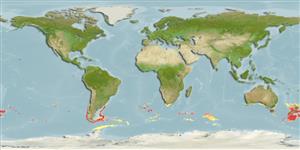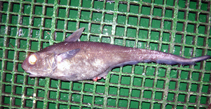Add your observation in Fish Watcher
| Native range | All suitable habitat | Point map | Year 2050 |

|
| This map was computer-generated and has not yet been reviewed. |
| Macrourus carinatus AquaMaps Data sources: GBIF OBIS |
Upload your photos and videos
Pictures | Google imageMacrourus carinatus
Picture by Reyes, P.
Pictures | Google imageMacrourus carinatus
Picture by Reyes, P.
Argentina country information
Common names:
[No common name]
Occurrence: native
Salinity: marine
Abundance: | Ref:
Importance: | Ref:
Aquaculture: | Ref:
Regulations: | Ref:
Uses: no uses
Comments:
National Checklist: Argentina
Country Information: https://www.cia.gov/library/publications/resources/the-world-factbook/geos/ar.html
National Fisheries Authority:
Occurrences: Occurrences Point map
Main Ref: Cousseau, M.B., 1993
National Database:
Occurrence: native
Salinity: marine
Abundance: | Ref:
Importance: | Ref:
Aquaculture: | Ref:
Regulations: | Ref:
Uses: no uses
Comments:
National Checklist: Argentina
Country Information: https://www.cia.gov/library/publications/resources/the-world-factbook/geos/ar.html
National Fisheries Authority:
Occurrences: Occurrences Point map
Main Ref: Cousseau, M.B., 1993
National Database:
Common names from other countries
Classification / Names Nombres comunes | Sinónimos | Catalog of Fishes(Género, Especie) | ITIS | CoL | WoRMS | Cloffa
> Gadiformes (Cods) > Macrouridae (Grenadiers or rattails)
Etymology: Macrourus: Greek, makroura = great tail (Ref. 45335).
More on author: Günther.
Etymology: Macrourus: Greek, makroura = great tail (Ref. 45335).
More on author: Günther.
Environment: milieu / climate zone / depth range / distribution range Ecología
marino batidemersal; no migratorio; rango de profundidad 200 - 1200 m, usually 500 - 800 m (Ref. 1371). Deep-water; 34°S - 65°S, 180°W - 180°E (Ref. 1371)
Distribución Países | Áreas FAO | Ecosistemas | Ocurrencias, apariciones | Point map | Introducciones | Faunafri
Southern Atlantic, Indian and Pacific: Subantarctic to temperate waters on both sides of South America, Falkland Islands, Discovery Tablemount and Meteor Seamount, South Africa, off Crozet and Prince Edward Islands, and off New Zealand and Macquarie Island.
Length at first maturity / Tamaño / Peso / Age
Maturity: Lm 57.5, range 55 - 60 cm
Max length : 100.0 cm TL macho / no sexado; (Ref. 1371); edad máxima reportada: 19 años (Ref. 7059)
Max length : 100.0 cm TL macho / no sexado; (Ref. 1371); edad máxima reportada: 19 años (Ref. 7059)
Short description Claves de identificación | Morfología | Morfometría
Espinas dorsales (total) : 2; Espinas anales: 0. Head short, its underside moderately to extensively scaled, but sometimes only a file or narrow band of small scales is present below the suborbital and preopercular ridges and posteriorly on lower jaw. Eyes relatively large. Snout short, moderately pointed, with small naked patches on dorsal surface behind leading edges. Pyloric caeca 13 to 21. Overall color is medium brown to somewhat straw color; fins darker, blackish in some; the dorsal and pelvic fins darker distally; oral cavity lining dark gray or brown.
A benthic species found on the continental slope (Ref. 75154). This species is being imported and sold to the United States by the Argentines under the name grenadero (Ref. 5171).
Life cycle and mating behavior Madurez | Reproducción | Puesta | Huevos | Fecundidad | Larva
Main reference
Upload your references | Referencias | Coordinador : Iwamoto, Tomio | Colaboradores
Cohen, D.M., T. Inada, T. Iwamoto and N. Scialabba, 1990. FAO species catalogue. Vol. 10. Gadiform fishes of the world (Order Gadiformes). An annotated and illustrated catalogue of cods, hakes, grenadiers and other gadiform fishes known to date. FAO Fish. Synop. 125(10). Rome: FAO. 442 p. (Ref. 1371)
Threat to humans
Harmless
Human uses
Pesquerías: comercial
FAO(pesquerías: producción; publication : search) | FishSource | Sea Around Us
Más información
Trophic ecology
componentes alimenticios
Composición de la dieta
consumo de alimento
Food rations
Despredadores
componentes alimenticios
Composición de la dieta
consumo de alimento
Food rations
Despredadores
Population dynamics
Coeficiente del crecimiento para
Max. ages / sizes
Length-weight rel.
Length-length rel.
Length-frequencies
Mass conversion
Reclutamiento
Abundancia
Coeficiente del crecimiento para
Max. ages / sizes
Length-weight rel.
Length-length rel.
Length-frequencies
Mass conversion
Reclutamiento
Abundancia
Life cycle
Reproducción
Madurez
Fecundidad
Puesta
Spawning aggregations
Huevos
Egg development
Larva
Dinámica larvaria
Reproducción
Madurez
Fecundidad
Puesta
Spawning aggregations
Huevos
Egg development
Larva
Dinámica larvaria
Anatomy
Superficie branquial
Brain
Otolith
Superficie branquial
Brain
Otolith
Physiology
Body composition
Nutrients
Consumo del oxígeno
Tipo de natación
Velocidad de natación
Visual pigments
Fish sound
Diseases & Parasites
Toxicity (LC50s)
Body composition
Nutrients
Consumo del oxígeno
Tipo de natación
Velocidad de natación
Visual pigments
Fish sound
Diseases & Parasites
Toxicity (LC50s)
Genetics
Genética
Heterozygosity
heritabilidad
Genética
Heterozygosity
heritabilidad
Human related
Aquaculture systems
Perfiles de acuicultura
Razas
Ciguatera cases
Stamps, coins, misc.
Aquaculture systems
Perfiles de acuicultura
Razas
Ciguatera cases
Stamps, coins, misc.
Herramientas
E-book | Guía de campo | Claves de identificación | Asistente para frecuencias de tallas | Herramienta de ciclo de vida | Mapa de puntos | Classification Tree
| Catch-MSY |
Special reports
Download XML
Fuentes de Internet
Aquatic Commons | BHL | Cloffa | Websites from users | Check FishWatcher | CISTI | Catalog of Fishes(Género, Especie) | DiscoverLife | ECOTOX | Faunafri | Fishtrace | GenBank(genome, nucleotide) | GloBI | GOBASE | | Google Books | Google Scholar | Google | IGFA World Record | MitoFish | Bases de datos nacionales | Otolith Atlas of Taiwan Fishes | PubMed | Reef Life Survey | Scirus | SeaLifeBase | Árbol de la vida | Wikipedia(Go, búsqueda) | World Records Freshwater Fishing | Expediente Zoológico
Estimates based on models
Preferred temperature (Ref. 115969): 3.2 - 8.1, mean 6.7 (based on 164 cells).
Phylogenetic diversity index (Ref. 82804): PD50 = 0.5312 [Uniqueness, from 0.5 = low to 2.0 = high].
Bayesian length-weight: a=0.00275 (0.00168 - 0.00450), b=3.18 (3.04 - 3.32), in cm Total Length, based on LWR estimates for this species & (Sub)family-body (Ref. 93245).
Nivel trófico (Ref. 69278): 3.7 ±0.58 se; based on food items.
Resiliencia (Ref. 120179): Bajo, población duplicada en un tiempo mínimo de 4.5-14 años (tmax=19).
Fishing Vulnerability (Ref. 59153): High vulnerability (60 of 100).




